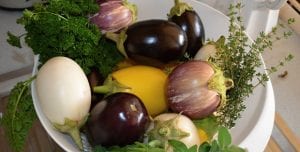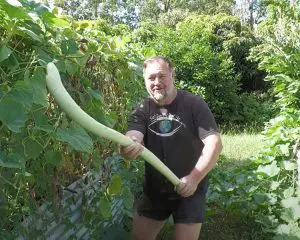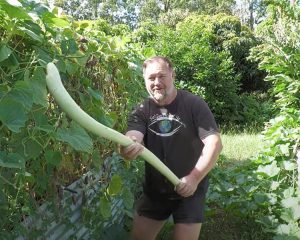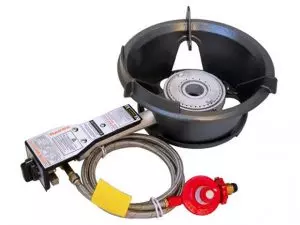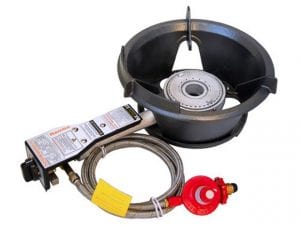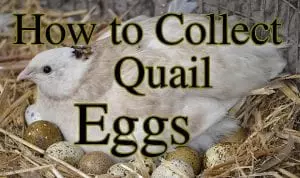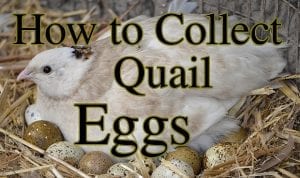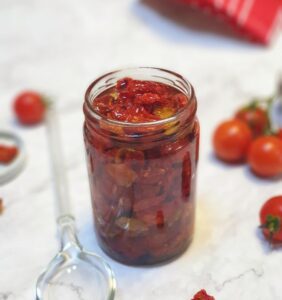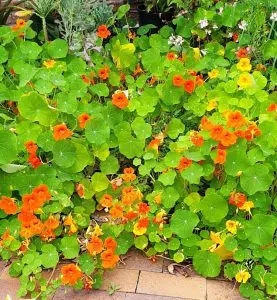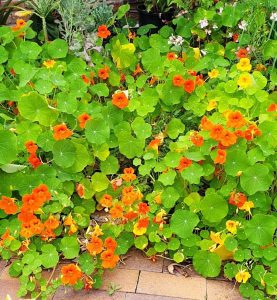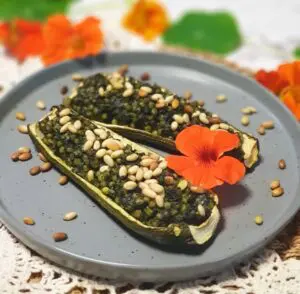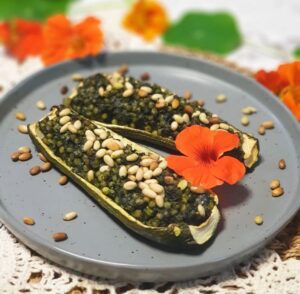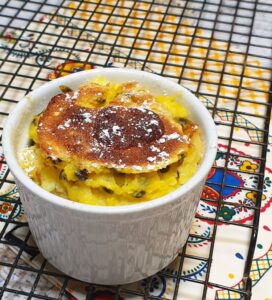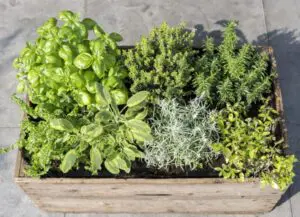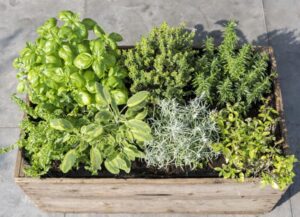Fruit trees are arguably the best and most important plants people can grow in their garden. These trees provide us with good healthy food, fantastic scenery, habitat for animals, and an excellent excuse to wander out through the orchard (or garden).
Most fruit trees have similar sighting considerations, and whilst there are some exceptions, trees positioned in full-sun and planted in well draining fertile soil will often do best. However, sighting for the tree's best interest can clash with our landscaping plans or impede other aspects of our garden. Therefore, if we really want to grow a particular tree and if compromises need to be made then erring on the side of good growing conditions above anything else is the way to go because what's the use of planting a fruit tree if it isn't going to perform and thrive?
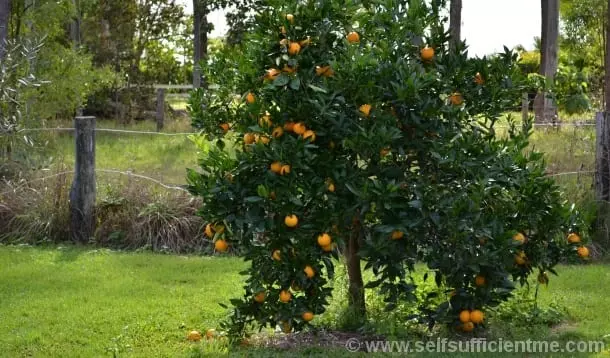
Here is a young orange tree (Valencia) thriving and producing fruit (image above)
Why transplant a fruit tree?
Nevertheless, even the most careful consideration and planning sometimes results in a fruit tree being planted in the wrong spot. It could be in a position where we just don't want it there anymore or in a spot that just isn't good enough for optimal growth and health of the tree. Once, I had a mandarin tree which was planted in perfect soil but was growing poorly and I realised a large ant nest had developed right through the root system. Transplanting this tree saved its life and my money.
For for whatever reasons, often issues with fruit trees become prevalent over time. When this situation happens, we are faced with really only two courses of action. Either leave the tree where it is and deal with the consequences or remove the tree.
An established fruit tree is expensive to buy; relocating a tree, rather than chopping it out or leaving it die a slow death in a position it hates, will save money and growing time.
It's important to remember just because a tree has been growing in a certain position for a length of time (possibly years) it can be removed and transplanted successfully with a little forethought and care. A fruit tree should be thriving not just surviving and moving the tree to a better position can make a world of difference. Even if a tree is thriving but the positioning is inconvenient it's best to move the tree rather than be constantly annoyed of its presence whenever you venture into the garden.
Yes, it is possible relocating the tree will kill it anyway due to transplant shock but at the end of the day the risk is worth the effort… in my humble opinion.
Steps to relocating a fruit tree
There are 4 main steps to relocating a fruit tree and these are: establish the new location, prune, Dig-out, and re-plant. Let's go through these steps one-by-one and in order below.
In the following example images shown in the rest of this article, I had planted a mulberry tree in a position where at the time seemed perfect. However, over a few years and consecutive excessive wet seasons it became apparent the tree was suffering from wet feet as the once free draining soil was now an almost permanent bog.
The tree didn't have to be moved very far to solve the wet feet problem, it just had to be moved away from the depression it was in and to a higher point on my property. To be certain I wouldn't have the wet feet issue again, I planted the tree almost at ground level and built the soil up rather than digging a large hole. I also timed the transplant during winter (hence the sparce foliage) so the tree was in its most dormant state to cope best with transplant shock.

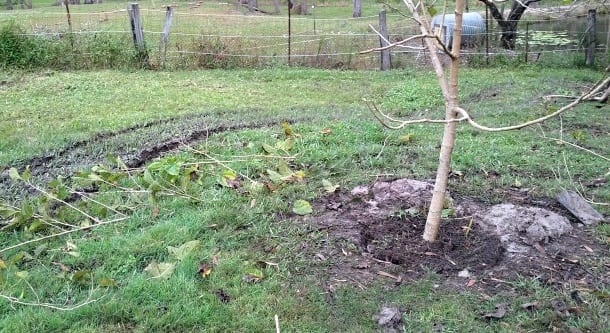
The image above shows the location of the mulberry fruit tree before transplanting. On the left are tyre tracks from where I nearly bogged my ride-on mower – this demonstrates how saturated the soil surrounding the tree had become. Here, I have begun the process of transplanting by pruning and clearing the base of the tree for digging out.
Step 1 – Establish the new location
The first thing that should be done is a yard reconnaissance to find a spot where the transplanted tree will go. Digging the tree out first and then deciding on where it is to go will just cause unnecessary stress for the tree and could cause you to make another ill-considered decision.
The obvious aim for where the tree should go is a location which improves on its current position. A hole in the new location should be pre-dug and any excess soil, compost, or mulch required should be pre-positioned near the hole.
Along with location is timing and winter is generally a good time for replanting as most fruit trees are semi or fully dormant during this time. If the tree happens to be fruiting through winter (like some citrus in the sub-tropics) then transplanting can be done after fruiting but before the start of the new spring growth. That way, growth won't be “checked” at the most important time of the year and the following growth season after transplanting can take immediate effect getting the tree off to a good start in its new location.
Step 2 – Prune
To minimise water loss through evaporation and encourage a flush of new growth a good pruning should be done before transplanting.
Pruning whilst the tree is in its current location is easier because it already has a firm footing so removing branches is easier and pruning before moving means less tree to move and a tidier tree to move.
Give the tree a really good trim cutting back to just above nodes or likely new growth points where possible. Ensure any crossing branches or dead-wood are pruned also, and try to open the centre of the tree to allow good air circulation.

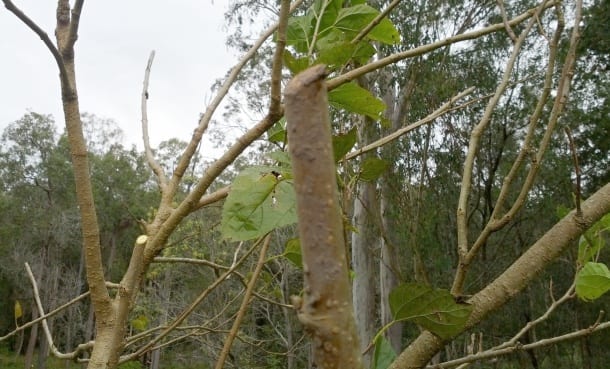
Some results of pruning before transplanting (above image)
Step 3 – Dig-out
Work around the tree digging down until a full circle has been cut then start moving around again using the same spade entry and start lifting and loosening the root ball. Depending on the size of the tree, it may be easy enough to lift out at this stage with the spade or by lifting at the trunk. For larger trees it may be necessary to gently push the tree over on one side and back the other way to fully loosen the root system and surrounding soil.
Keeping as much of the root ball as possible will reduce transplant shock. Having said that, the tree still needs to be manageable so digging out a massive hunk of ground with the roots is not practicable if it can't be moved due to the weight (unless you have machinery – like a digger: My father in-law used to own a commercial orchard and he tells me how using a digger can be a very effective way to dig-out, move, and transplant large fruit trees). But, if it's manpower you're using then weight is a definite consideration when digging out the tree.

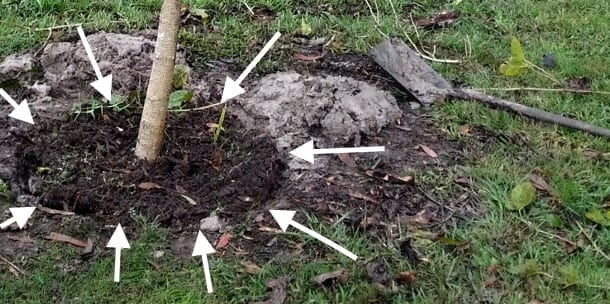
Digging a spade depth down around the base of the tree on a slight angle inwards (above image)
The two most important roots on a fruit tree is it's tap root and feeder roots. The tap root is the root which is generally situated under the trunk going straight down. Severing the tap root too close to the base can be bad because it is like a main artery for the tree. Feeder roots are the surface roots (close to t
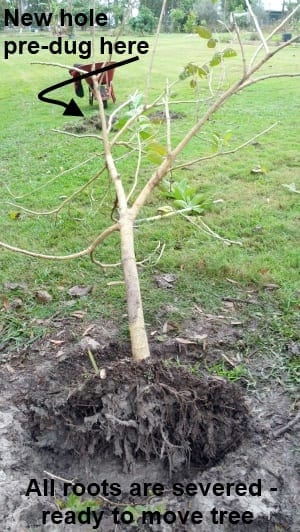
With the two important root systems in mind it's time to start digging. A spade with a sharp edge is optimal for this task as it will be used to sever the root system cleanly. With the spade angled slightly inward not straight down and about 45cm away from the base of the tree firmly push down the full depth of the blade. If a root is hit and the spade fails to cut through then a few hard step-downs on the spade should get through.
Eventually, the tree should feel like it has “come away” if it feels like it is still bound to the ground then it probably still is; therefore, it is likely some deeper roots have been missed. Just find these anchor roots by pushing the tree to one side (or the other) and cut them. With some effort, the tree should then lift out and have most or all of its tap root intact.
When lifting the fruit tree (you may need some help) try to do so with as little disturbance to the roots as possible. Soil can be lost from below the feeder roots but try to keep some of the top soil attached to the feeder roots.
Step 4 – Re-plant
Depending on how far the tree needs to be transported extra equipment might be required fo
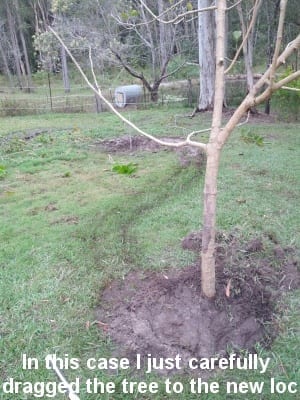
Position the tree in the new hole and take the time to ensure the orientation is how you like, before starting to backfill, as this is the time to turn the tree so it is positioned best. If the tree is being planted into dry soil then pre-wetting the hole is a good idea, also.
Backfill the new hole ensuring the tree trunk is at the same ground height as before and the soil doesn't encroach around the trunk base above the original collar mark. Gently firm-down the soil then top with some well matured compost and water-in with a watering can full (9ltrs) of a seaweed solution (recommended dose) to help the tree cope better with transplant shock. Mulch well with sugar cane or lucerne to retain moisture and protect the newly transplanted roots from the elements.
Staking the tree at this point can also be helpful until the tree has re-established a solid root system. Two stakes driven-in on each side of the root ball (not through it) with some material or twine from one to the other in a figure 8 style tie works well.

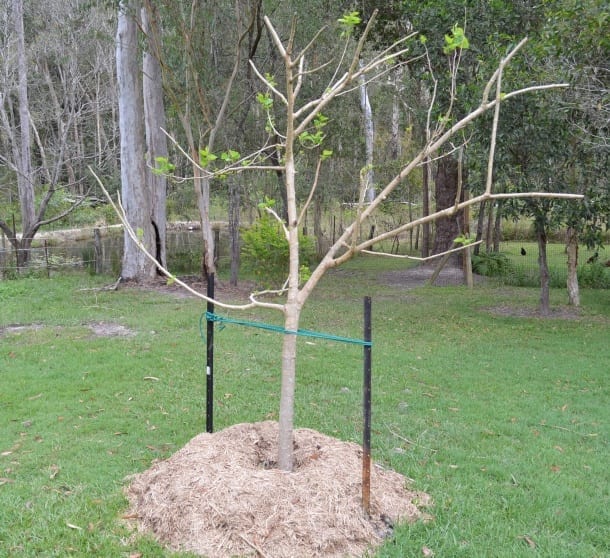
Here we have the mulberry tree staked and mulched (image above)
Finally, water the newly transplanted fruit tree regularly until established and this is particularly important in the warmer climates where some winter days can be quite dry and warm.
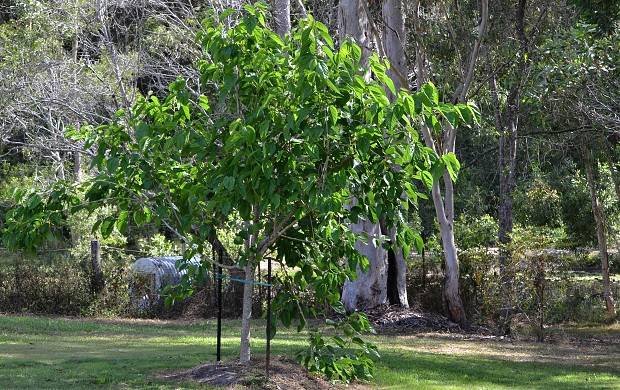

Here's the same tree a just over 12 months later and it's doing well (image above)
Other points
Some fully dormant fruit trees (like stone fruit) can be removed and the roots washed clean to become bare rooted before transplanting (deciduous fruit trees are often sold like this) but I still think transplanting with minimal root disturbance is best (unless a disease or pest happened to be attacking the root system, in which case, bare rooting the plant by washing off the soil might be good practice).

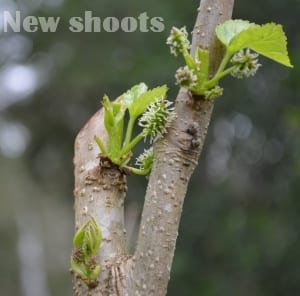
Use clean garden tools to ensure no new disease is introduced just on transplanting. A light spray with a disinfectant over tools like secateurs, for example is all that's required.
Conclusion
A month on, and healthy shoots appearing on the transplanted tree is a really good sign (image left).
For a fruit tree to do its job and provide us with edible, great tasting, nutritious produce we need to provide it with the best growing conditions we can offer. Therefore, sometimes relocating the tree is necessary in order to facilitate the best growing conditions.
The alternative is to persist with the tree in the current location and “baby it” but from my experience all the fertiliser and doting in the world is just palliative care for a dying tree. The only real chance for the tree to live a good existence is to take it from the location, which is making it sick, and place it in an environment to help it thrive.
I buy a lot of my fruit trees online because of the variety – try:
Feel free to use the comment section below and have your say (no email is required).
Thanks for reading and thanks for your support.
Look, and see the Earth through her eyes
Mark Valencia – Editor SSM


